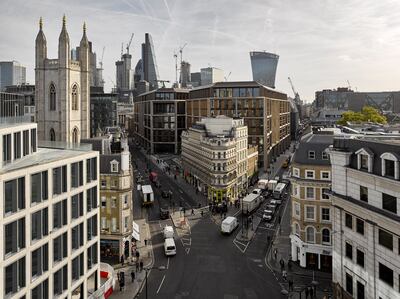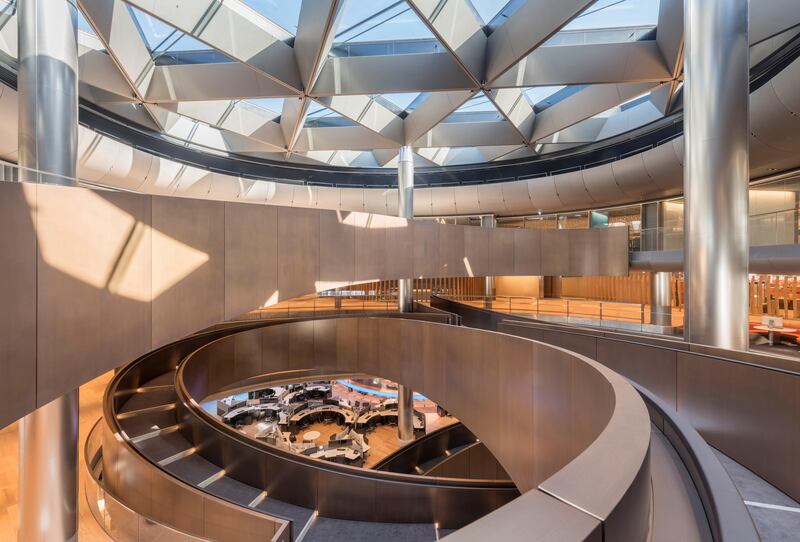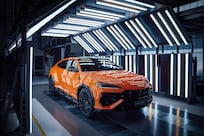The world has a new role model for green buildings, with the opening of Bloomberg’s new headquarters in London’s famous Square Mile.
Billed as the most sustainable office building in the world, the enormous complex – based in two buildings joined by bridges – uses 70% less water and 40% less energy than a typical office block.
At 1.1 million square foot, it’s bigger than the Bank of England, and will house over 4,000 staff. But, unlike other recent developments in the city, such as the Walkie Talkie building, the Gherkin and the Shard, it sprawls out horizontally rather than vertically, with public spaces and a huge new pedestrianised walkway.
Unveiling the new headquarters at an event on Tuesday, Michael Bloomberg, the founder and chief executive of Bloomberg said: “For many companies our size, building a new headquarters would have meant opting for a glass skyscraper, and given the price of London real estate and the cost of construction materials, the economics would bear that out.
“But at Bloomberg we have never made decisions based on short-term costs.”
Instead, the complex – reported to have cost as much as £1 billion – was capped at a modest height of ten storeys. It was also deliberately designed to blend into its London surroundings, clad in almost 10,000 tonnes of English sandstone.

It is covered in bronze blades that act as "gills", opening and closing to allow natural ventilation. The ceilings are decked with 500,000 LED lights, which greatly reduce the energy consumption compared to a typical fluorescent office lighting system.
“As a global company, we aim to get 100% of our power from renewable resources by 2025,” Mr Bloomberg said.
This building will help the company get there. It received a 98.5 per cent score on the BREEAM environmental rating scheme – the highest score achieved by any commercial building in the world.
Tucked away behind St Paul’s Cathedral and alongside parts of the old London wall, the building has its own connection to antiquity. It is built on one of London’s most significant archaeological sites, home to the ancient Temple of Mithras and at the heart of what was Roman London’s commercial centre. The temple has been restored to the site, and the public will be able to visit it for free from next month.
_______________
Read more:
[ Frankfurt winning race for post-Brexit banking spoils ]
[ Goldman Sachs steps up post-Brexit plans with new Frankfurt offices ]
[ Why Hong Kong investors are snapping up London's "trophy" assets ]
_______________
The centrepiece of the building’s interior is a spiralling ramp spanning nearly 700 feet and six floors in a triple-helix formation.
Mayor of London Sadiq Khan praised the “fantastic” new building.
“Mike, I don’t know about the Romans, but I think this building is more futuristic than the latest Blade Runner movie,” Mr Khan joked. “This building really does represent a glimpse into the future.”
The Mayor praised the man behind the design, architect Lord Norman Foster, and said he was confident that the new building would “inspire collaboration, and fuel innovation, and be a great example in sustainable office design”.
Mr Khan also welcomed Bloomberg’s decision to build its new headquarters in London, calling it a “vote of confidence” in the city.
“The fact that London has been chosen as the home of Bloomberg’s European headquarters sends a clear message to the world about the value of investing in this great city, and thus remaining a part of Europe’s commercial market.”
He added: “It also shows that despite Brexit, London is open – open to business, open to investment, and open to some of the best design in the world.”
Mr Bloomberg echoed that sentiment, saying that his company has been in London for 30 years, and remains extremely committed to the city. “We have a great future here in London, and this is a big investment in the city.”
The construction has its own entrance to Bank underground station, and a large pedestrianised dining area with ten new restaurants. World-leading artists including Cristina Iglesias, Michael Craig-Martin and Olaf Eliasson were commissioned to create site-specific works for the complex, including in the three public plazas.
Lord Foster paid tribute to the “civic pride” and “social idealism” that lay behind the project, and praised it as an “extraordinary collaboration between the public world and the private world.”
He added: “I think that’s a great combination to celebrate”.






